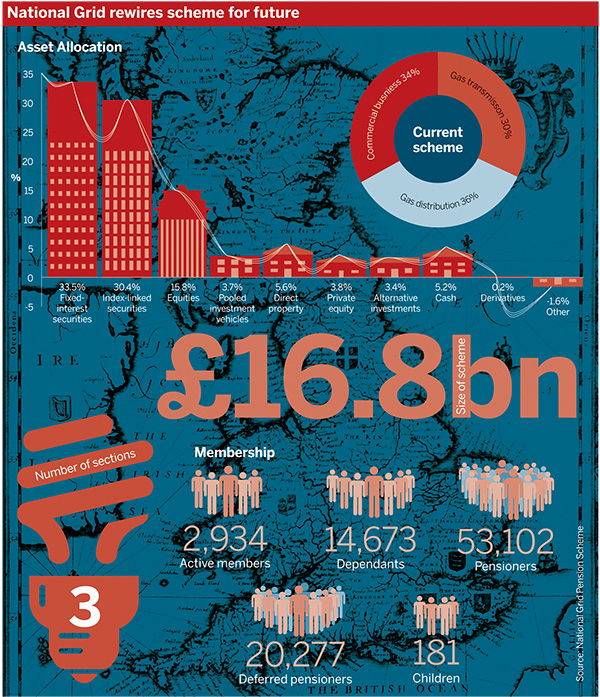National Grid has decided on the section allocation of scheme members after agreeing on the creation of three independent sections within the National Grid UK Pension Scheme earlier this year
In June this year, the scheme informed members that the fund would be split into three independent sections to protect benefits while facilitating the employer’s sale of a majority stake in its gas distribution business.
The scheme confirmed in November which sections members are being allocated to. Section A will be sponsored by National Grid’s commercial businesses, which are not regulated by Ofgem. Section B will be sponsored by the company’s gas transmission business, while Section C will be sponsored by the new gas distribution business.
 Allocating members to different sections involved an “agreed robust methodology”, which was independently verified, according to the scheme.
Allocating members to different sections involved an “agreed robust methodology”, which was independently verified, according to the scheme.
Sectionalisation is a very good way of achieving the objectives required by the company, at the same time as protecting members’ interests
Richard Farr, Lincoln Pensions
The scheme said the trustees took professional advice and worked together with the company “to ensure that each of the three sections of the scheme will have a source of committed financial support”.
“The proportions of the allocations between the three sections, including assets and liabilities and therefore the deficit, will be calculated in accordance with the regulated proportions as agreed with Ofgem,” the scheme explained.
Nigel Stapleton, chair of the trustee board, said that each section “will be ringfenced from the two others, with separately identified assets and liabilities”.
With regard to the finalisation of the process, Stapleton said: “We expect this to happen during the first quarter of next year.”
The scheme and its three sections will continue to be managed by the members’ trustee board, he said.
Identifying members
Richard Farr, managing director at covenant specialist Lincoln Pensions, said sectionalisation allows the allocation of “the relevant liabilities to each separate company that is being spun off or reorganised” so “it’s a very powerful tool”.
Sectionalising a scheme “facilitates corporate change”, he said. It is “a very good way of achieving the objectives required by the company, at the same time as protecting members’ interests”.
One key point is making sure that the covenant is at least as strong as it was before the sectionalisation, said Farr.
“Clearly if you move from a strong company to a weak company that’s not good for the members.”
Identifying the appropriate section
Lesley Browning, partner at law firm Norton Rose Fulbright, said that when communicating this kind of change, it helps to send out a clear message that “members are just as secure as they were beforehand”, said Browning.
Browning noted that the main practical issues that arise when looking to sectionalise a scheme include identifying “which employees go into which section, and which assets should follow the employees”.
She highlighted the need to comply with the requirements of the scheme funding regulations for multi-employers schemes.
One of the main conditions that need to be met when establishing separate scheme sections involves ensuring that “any contributions are payable and allocated to one particular section for one employer or group of employers”, said Browning.
The other key condition is “that a specified portion of the assets of the scheme is attributable to each section, and can’t be used for the purposes of any other section”.
No mirror scheme needed
Jeanette Holland, partner at law firm Baker & McKenzie, said that sectionalisation can be “a very useful mechanism”.
It is a good way of ensuring “that each employer knows particularly what they’re responsible for and isn’t inadvertently… over time… ending up potentially picking up liabilities for other parts of the scheme that they were never primarily responsible for”, she explained.
She said it is important to be aware that “it’s not as simple as just assuming that there is one set of legal requirements” and boxes to tick when sectionalising a scheme.
Where a business or part of it is being sold, depending on who purchases the business, setting up a scheme within a scheme means that “the new purchaser can continue in the same scheme without going to all the trouble and cost of setting up a mirror image scheme to which the people and the relevant benefits are transferred”, said Holland.






















